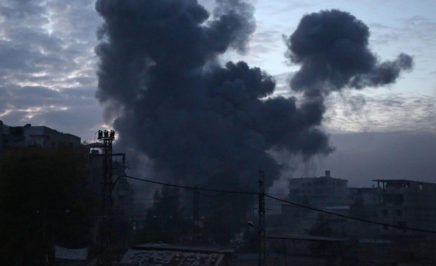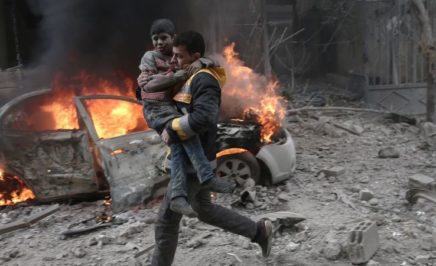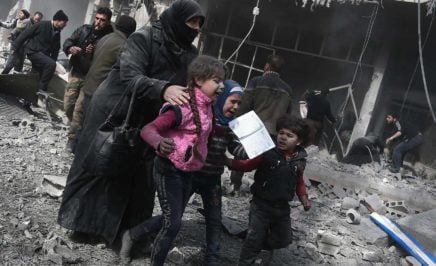- Verified photographs show Soviet-made cluster munitions used over densely populated areas by Syrian government forces
- Doctors describe dire humanitarian situation – including widespread malnutrition – amid tightening siege
- Witnesses recount indiscriminate attacks killing civilians as Syrian forces commit daily war crimes
Syrian government forces’ increasing use of banned Soviet-made cluster munitions to carry out indiscriminate attacks and direct attacks on civilians amid a tightening siege in rebel-held Eastern Ghouta has killed at least 10 civilians and brought the area’s humanitarian crisis to breaking point, Amnesty International can reveal today.
The organisation interviewed five people currently under siege in Eastern Ghouta, among them activists and medical professionals, who described a severely deteriorating situation as the government has escalated its bombing campaign of this rebel-held enclave, near the capital, Damascus, since 14 November.
“The Syrian government is committing war crimes on an epic scale in Eastern Ghouta. Using its familiar, brutal strategy of siege and bombardment of civilians – already employed to devastating effect in Aleppo, Daraya and other rebel strongholds – the population is being forced to surrender or starve,” said Philip Luther, Amnesty International’s Research and Advocacy Director for the Middle East and North Africa.
“Amid a worsening malnutrition epidemic, Syrian forces must immediately end the unlawful siege of Eastern Ghouta and allow unimpeded access to humanitarian organisations before an already catastrophic situation claims yet more civilian lives.”
Attacks on civilians and civilian objects
“I clearly saw parachutes strapped to small bombs falling, and 10 seconds later a series of explosions echoed.” – Mustafa, civil defence volunteer
Images shared by activists in Eastern Ghouta, which have been verified by Amnesty International’s arms expert, show remnants of cluster munitions from attacks that have taken place in the past 10 days, including one on 19 November.
Appearing in the images are Soviet-made ground-launched 240mm 3O8 cluster munitions projectiles containing up to 10 sub-munitions. According to Landmine and Cluster Munition Monitor, these first appeared in Syria after Russia began missile strikes against anti-government groups in September 2015.
Such weapons are banned by more than 100 countries due to the enormous danger presented to civilians by their indiscriminate nature.
“The Syrian government has shown callous disregard to the lives of the hundreds of thousands of people living in Eastern Ghouta since it laid siege to the area in late 2012. But this recent escalation in attacks – clearly targeting civilians and civilian infrastructure using internationally banned cluster munitions – is horrific,” said Philip Luther.
“There are around 400,000 civilians struggling to survive under daily, often hourly, bombardment, without access to food and medical care.”
Activists told Amnesty International the Syrian government also attacked residential areas with imprecise, improvised rockets such as “Elephant rockets”, named in connection with the distinctive noise they make when launched.
According to the Violations Documentation Centre in Syria, a local monitoring group, 97 civilians were killed in ground and air attacks by government forces between 14 and 26 November 2017.
Amnesty International interviewed two people who witnessed an attack by Syrian government forces using cluster munitions projectiles on al-Quawtli, a densely populated residential neighbourhood close to the Grand Mosque in Douma.
Mustafa, a volunteer with the civil defence, which carries out rescue work after military attacks, witnessed an attack on a crowded market on 19 November. He told Amnesty International:
“I heard the launch of the rocket because the government military base is close. Then I clearly saw parachutes strapped to small bombs falling and, 10 seconds later, a series of explosions echoed. After that, the shelling continued but the sound was different.
“I went to the scene of the attack and saw injured people on the floor, including women, children and men. Several people later died of their injuries.”
Amnesty International analysed four videos posted online showing what were claimed to be cluster munition explosions by the Grand Mosque and verified that the images of the parachutes used to deliver the sub-munitions of the 240mm 3O8 cluster munitions projectiles used in the attack (see attached, copyright: Firas Abdullah) were taken in Douma.
Muhammad, a media activist, witnessed an attack that hit a residential building. He recalled:
“The missiles struck two residential buildings surrounding a market, which is usually crowded with shops and children playing.
“At the scene of the attack, I saw the civil defence removing the body of a girl around six years old. Her name is Ghina. Her family survived but she didn’t. She was in one of the buildings that was hit. Thankfully, the warplane didn’t hit the market or else there would have been more casualties.”
Humanitarian crisis escalates
“All the children who come to me are skeletons, bones and skin.” – Hoda, a doctor in Eastern Ghouta
Since the Syrian government captured the areas of al-Qaboun and Barze, which both border the Harasta neighbourhood of Eastern Ghouta, in February 2017, smuggling tunnels that had for years guaranteed a minimum flow of food, water and medical supplies to the besieged population have been closed.
As a result, the humanitarian situation inside Eastern Ghouta has rapidly deteriorated and food prices have increased exponentially, while hospitals have struggled to treat patients due to depleting stocks. On 3 October 2017, the Syrian government further tightened the siege by closing the last remaining entry point to Douma, the al-Wafideen checkpoint.
Muhammad, a media activist in Eastern Ghouta, described to Amnesty International how medical workers are struggling to provide adequate care to people facing malnutrition and injury, due to lack of supplies. He said:
“Outsiders think we are exaggerating but we are not. We barely have food. My wife and I had to cut down by half the amount of food we are eating. It is impossible to afford to buy food with the current prices, which are four times more than before.”
According to the World Health Organisation’s food security report, published on 22 November, by mid-November 2017 a 700g bundle of bread was 85 times more expensive in Eastern Ghouta than in Damascus, located just 15km away.
Hoda, a doctor working in one of the field hospitals in Eastern Ghouta, described the scale of malnutrition crisis to Amnesty International:
“Hospitals are now relying on humanitarian aid convoys that are rarely allowed to enter. The last humanitarian aid convoy that entered Kaferbatna [a neighbourhood in Eastern Ghouta] was a month ago [October]. It carried a very small amount of medical aid. We need fuel, anesthetics, oxygen, antibiotics… We are seriously running out of these supplies.
“The children are suffering the most. I am receiving lots of cases of malnutrition. They need food for energy and their immune systems, but their families can’t afford to buy them any food so they end up eating barley, which is affordable, once a day. That’s it.
“We don’t have cases of children dying from malnutrition but all of the children who come to me are skeletons, bones and flesh. One child I saw is 10 months old and weighs 800g. All of the children are underweight without any exception.”
In October, the UN’s children’s fund, UNICEF, announced that 232 children in Eastern Ghouta were suffering severe acute malnutrition.
“Russia, as a party to this conflict has a particular responsibility to ensure that its ally, the Syrian government, ends this unlawful siege and stops committing war crimes. Other states must use their influence to pressure Syria to allow unfettered impartial humanitarian relief to reach besieged civilians in Eastern Ghouta and elsewhere in Syria,” said Philip Luther.
Background
In August 2015, Amnesty International published a report documenting the unlawful siege of Eastern Ghouta and attacks on civilian objects. In November 2017, it released a report on mass displacement inside Syria, exposing the government’s strategy of prolonged sieges with the aim of forcibly displacing the local population. It has been documenting violations and abuses by all parties in Syria since the onset of the crisis.
Amnesty International has been calling on all states for years to immediately halt the use, production, transfer and stockpiling of cluster munitions and to join the 2008 Convention on Cluster Munitions (CCM).




